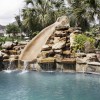Elevation
Elevation in the context of pool building refers to the height at which the pool is set relative to the surrounding ground level. It’s a crucial factor in the design and construction phase, impacting drainage, access, and the overall aesthetics of the pool area. Proper elevation ensures that water flows away from the pool and house, reducing the risk of flooding and water damage. It can also enhance the visual appeal of the pool, creating a more integrated look with the landscape.
Filter Media
Filter media are the materials used inside pool filters to trap and remove dirt, debris, and other contaminants from the water. The type of filter media used depends on the kind of filtration system installed. Common filter media include sand for sand filters, cartridge elements for cartridge filters, and diatomaceous earth (DE) for DE filters. Each media type has a different level of filtration efficiency, with DE filtering out the smallest particles, followed by cartridge and then sand.
Filtration System
The filtration system is a critical component of a swimming pool’s circulation system, designed to remove impurities and particulates from the water to maintain clarity and hygiene. It typically consists of a pump, filter, and plumbing. The three main types of pool filters are sand, cartridge, and diatomaceous earth (DE) filters, each using different media to trap debris. The choice of filtration system affects the water quality, maintenance requirements, and operational costs of the pool.
GPM (Gallons Per Minute)
GPM stands for Gallons Per Minute, a measurement indicating the flow rate of water through the pool’s filtration system. It’s an essential factor in determining the efficiency of the pool pump and filter, ensuring that the entire volume of pool water is adequately circulated and filtered within a specific time frame. The required GPM rate depends on the pool size and the capacity of the filtration system, aiming for complete water turnover every 8 to 12 hours for optimal cleanliness.
Gunite
Gunite is a specific type of concrete that is sprayed onto the rebar framework of a pool under high pressure, forming the structural base for many in-ground pools. It’s a mixture of cement, sand, and water applied through a pneumatic hose. Gunite pools are known for their durability and flexibility in design, allowing for customized shapes and sizes. After application, the gunite is smoothed and then finished with a waterproof coating or plaster.
Heat Pump
A heat pump is a device used to heat the pool water by extracting heat from the air or ground and transferring it to the water. It’s an energy-efficient method of pool heating, as it uses the heat from the environment rather than generating heat through combustion or resistance. Heat pumps are ideal for maintaining a comfortable water temperature, extending the swimming season without the high operational costs associated with traditional pool heaters.
Hydrostatic Pressure
Hydrostatic pressure refers to the pressure exerted by water in the soil surrounding the pool. This pressure can affect the structural integrity of the pool, especially if the water table is high or there are fluctuations due to heavy rain. Hydrostatic relief valves are often installed in the bottom of the pool to alleviate this pressure, preventing the pool shell from cracking or lifting. Understanding hydrostatic pressure is crucial during the pool design and construction phases to ensure long-term stability.
Hydraulic Design
Hydraulic design in pool construction involves planning the water circulation and filtration system, including the placement of pumps, filters, drains, and returns. It’s essential for ensuring efficient water movement throughout the pool, optimizing chemical distribution, and maintaining water clarity and health. A well-designed hydraulic system minimizes energy consumption while maximizing water filtration and circulation, requiring careful calculation of flow rates, pipe sizes, and equipment capacities.
Filtration Rate
The filtration rate refers to the speed at which pool water passes through the filter, typically measured in gallons per minute per square foot of filter area. This rate is crucial for determining the efficiency of the filtration system and ensuring that it can adequately handle the volume of water in the pool. An optimal filtration rate helps maintain clear and clean water by removing debris and contaminants effectively.
Grout
Grout in pool construction is a type of mortar used to fill the gaps between tiles or stones that are used in the pool’s finish, particularly in and around the pool deck, walls, and waterline. Grout helps to secure the tiles or stones in place and prevents water from seeping behind them, which could lead to damage. It comes in various colors to match or complement the tile or stone, enhancing the aesthetic appeal of the pool.
Heat Exchanger
A heat exchanger is a device in a pool heating system that transfers heat from one medium to another without mixing them. In pools, heat exchangers are used in heaters to transfer heat from a hot source (like a boiler or solar heated water) to the pool water. They are efficient for heating pools because they can utilize existing heating sources and maintain a consistent pool temperature.
Impeller
The impeller is a rotating part of the pool pump that drives the flow of water through the system. It spins at high speed, creating a centrifugal force that sucks water in through the pump’s intake and pushes it out through the discharge, ensuring the water circulates through the filter and back into the pool. The impeller’s efficiency can affect the overall performance of the pool’s circulation system.
Junction Box
A junction box in pool electrical systems is a waterproof enclosure that houses the connections between the underwater pool lights and the power source. It is typically mounted on the pool deck or nearby wall. The junction box is essential for safety, preventing water from coming into contact with electrical components and allowing for easy maintenance and inspection of the lighting system.
LED Lighting
LED lighting in swimming pools is used for illumination and aesthetic enhancements. LED lights are energy-efficient, have a long lifespan, and come in a variety of colors and brightness levels, allowing for customizable lighting schemes. They can be installed in and around the pool to enhance safety, create ambiance, and highlight architectural features of the pool and landscape.
Ladder
A pool ladder is a set of steps or rungs attached to the side of the pool to provide swimmers with a way to safely enter and exit the water. Ladders are especially important in deeper pools where it’s not possible to step in from the side. They are made from materials resistant to corrosion and slip, such as stainless steel or heavy-duty plastic, and are securely anchored to the pool deck or walls.
Liner
A pool liner is a waterproof material that covers the interior surface of a pool to prevent water from escaping and to provide a smooth, protective layer for swimmers. In vinyl-lined in-ground pools, the liner is a custom-made sheet that fits the exact shape and size of the pool, offering a cost-effective and visually appealing interior finish. Liners come in various patterns and colors, allowing for customization of the pool’s appearance.
Liquid Chlorine
Liquid chlorine is a form of chlorine used for sanitizing pool water. It is a highly effective disinfectant that kills bacteria, algae, and other harmful organisms, keeping the water safe for swimming. Liquid chlorine is typically added to the pool through a chemical feeder or by pouring it directly into the water, following the manufacturer’s guidelines to achieve the correct chlorine levels.
Main Drain
The main drain is a critical component of a swimming pool’s circulation system, typically located at the pool’s deepest point. It is designed to remove water from the pool for filtration, heating, and sanitization before it is returned to the pool through the return jets. The main drain helps in the removal of heavy debris and aids in the distribution of fresh, chemically treated water throughout the pool, contributing to overall water clarity and hygiene. Modern pools often have two main drains for safety reasons, reducing the suction effect and minimizing the risk of entrapment.
Mastic
Mastic is a flexible, waterproof sealant used to fill the expansion joint between the pool coping and the surrounding deck. This joint allows for the natural expansion and contraction of the pool and deck materials due to temperature changes, preventing cracking or damage. Mastic is designed to withstand the outdoor environment, including exposure to water, UV light, and chemicals, while maintaining a strong bond and flexibility.
Multiport Valve
A multiport valve is a versatile component of a sand or diatomaceous earth (DE) pool filter system. It allows the pool operator to control the flow of water through the filter for various functions with a single valve. Settings typically include “Filter” for normal operation, “Backwash” for cleaning the filter, “Rinse” for clearing out dirty water after backwashing, “Waste” for bypassing the filter to drain the pool, “Recirculate” for bypassing the filter during chemical treatment, and “Closed” for shutting off flow to the filter. The multiport valve simplifies maintenance and enhances the functionality of the filtration system.
Ozone Generator
An ozone generator is a device used in some swimming pools to produce ozone gas (O3), a powerful oxidizer that helps in the sanitization process. When injected into pool water, ozone assists in breaking down bacteria, viruses, and organic contaminants, reducing the reliance on traditional chemical sanitizers like chlorine. Ozone generators can improve water clarity and reduce odors and irritation associated with chlorine, making the pool water more pleasant for swimmers.
Plaster
Plaster is a type of finish applied to the interior surfaces of concrete (gunite or shotcrete) pools. It consists of a mixture of cement, sand, water, and sometimes colorants or additives for enhanced durability and aesthetics. Plaster provides a smooth, waterproof surface that is comfortable for swimmers and helps to reflect light, enhancing the water’s appearance. Over time, pool plaster may require resurfacing due to wear or chemical erosion.
Pool Cover
A pool cover is a protective barrier that can be placed over the surface of a pool when it is not in use. Pool covers serve multiple purposes, including reducing evaporation, retaining heat, keeping out debris, and enhancing safety by preventing accidental falls into the water. There are various types of pool covers, including solar covers, safety covers, automatic covers, and winter covers, each designed to meet specific needs and preferences of pool owners.
Pressure Gauge
A pressure gauge is a device attached to a pool’s filter system that measures the pressure of the water flowing through the filter. It is an essential tool for monitoring the filter’s performance and determining when maintenance, such as backwashing or cleaning, is needed. A significant increase in pressure indicates that the filter is becoming clogged with debris and requires attention to maintain efficient water filtration.
Pump Basket
The pump basket is a removable strainer basket located inside the pool pump’s housing. Its primary function is to catch and collect large debris, such as leaves and twigs, before they reach the pump impeller and potentially cause damage or blockages. Regularly cleaning the pump basket is an important maintenance task to ensure optimal water flow and prolong the life of the pool pump.
Return Jets
Return jets are the fittings through which filtered, heated, and chemically treated water is returned to the swimming pool from the filtration system. They are strategically placed around the pool to ensure even distribution of water and to facilitate the circulation pattern that helps keep the pool clean and well-maintained. The direction of the return jets can often be adjusted to control the flow of water and enhance the efficiency of the circulation.
Skimmer
A skimmer is an essential component of a swimming pool’s filtration system, typically mounted on the pool wall. It works by drawing water and floating debris (like leaves and bugs) off the pool surface into a basket before the water is sent through the pool’s filtration system. Skimmers help maintain clean water by removing debris before it sinks and becomes more challenging to remove. Most pools have one or more skimmers, depending on the pool size, to ensure efficient surface cleaning.
Saltwater System
A saltwater system, or saltwater chlorinator, is a pool sanitation system that uses dissolved salt (sodium chloride) as a store for the chlorination process. Instead of adding chlorine directly to the pool water, a saltwater system generates chlorine through electrolysis, where the dissolved salt is converted into chlorine gas, sanitizing the water, and then reverts back to salt. This process is continuous, providing a stable and lower concentration of chlorine, which can be less irritating to skin and eyes and reduces the chlorine smell.
Shock Treatment
Shock treatment refers to the process of adding a high dose of chlorine (or non-chlorine alternatives) to the pool water to rapidly increase the chlorine level. This process is used to break down organic contaminants, kill bacteria, and restore clarity to the water. Shocking is a critical maintenance task that helps to prevent algae growth and remove chloramines, which are chlorine molecules that have combined with ammonia or nitrogen and can cause skin irritation and a strong chlorine odor.
Solar Cover
A solar cover, also known as a solar blanket, is a large sheet of plastic bubble material that floats on the surface of the pool water. Its primary function is to increase water temperature by absorbing sunlight during the day and retaining heat during the night, reducing heat loss. Solar covers also help to minimize water evaporation and can keep debris out of the pool, reducing cleaning time and chemical use.
Tile
In swimming pools, tile is used to provide a durable and waterproof surface that offers both aesthetic appeal and practical functionality. Tiles can be made of ceramic, porcelain, glass, or stone and are used in various pool areas, including the waterline, pool floor, and walls. Tile choices range in color, size, pattern, and texture, allowing for customization of the pool’s appearance. They also facilitate cleaning and maintenance, resisting algae and stain buildup.
Turnover Rate
The turnover rate is the amount of time it takes to circulate the entire volume of pool water through the filtration system once. This rate is crucial for maintaining water quality and clarity, with most health codes requiring a turnover rate of 6 to 8 hours for public pools. The specific turnover rate necessary for a residential pool can vary based on the pool size, pump capacity, and filtration system efficiency.
Underwater Lighting
Underwater lighting in swimming pools is designed to enhance safety and aesthetics by illuminating the pool interior, allowing for nighttime swimming and creating a visually appealing atmosphere. These lights can be incandescent, LED, or fiber optic, each offering different levels of brightness, color options, and energy efficiency. Proper placement and installation of underwater lighting can transform the pool environment, highlighting water features and enhancing the overall ambiance.
Vacuum
A pool vacuum is a cleaning device used to remove debris from the pool floor and walls. Pool vacuums can be manual, requiring physical operation by the pool owner, or automatic, moving around the pool independently. They work by suctioning up dirt and debris into the pool’s filtration system or a collection bag. Regular vacuuming is essential for maintaining a clean and inviting pool environment.
Waterline Tile
Waterline tile is a band of tiling around the perimeter of the pool at the water’s surface level. It serves both a functional and decorative purpose, making it easier to clean the scum line that can form at the water’s surface and adding a stylish accent to the pool’s design. Waterline tiles are available in various colors, materials, and designs, allowing for customization to match or complement the pool’s overall aesthetic.
Weir
The weir is a component of the pool skimmer, a flap or door at the skimmer’s entrance that regulates water flow into the skimmer. The weir helps to increase the skimming efficiency by creating a uniform flow of water into the skimmer, catching debris more effectively. It also prevents debris from floating back out into the pool when the pump is turned off.
Zeolite
Zeolite is a naturally occurring mineral used as a filter medium in some pool filtration systems, offering an alternative to traditional sand or diatomaceous earth (DE). Zeolite’s microporous structure enables it to trap small particles and ammonia ions, improving water clarity and reducing odors. It also has the advantage of requiring less backwashing, saving water and maintenance time.

 At Casey’s Pools, we’re all about ensuring you have a smooth and enjoyable experience as you embark on the exciting journey of building your dream pool. We understand that the process can be a bit overwhelming, especially with all the technical jargon thrown around. That’s why we’ve put together this handy guide. Whether you’re just starting to explore the idea of adding a pool to your backyard oasis or you’re already in the deep end of planning and construction, this glossary will help demystify the process. Our goal is for you to feel informed and confident, not just during the building phase but also in maintaining your pool for years of fun and relaxation. Let’s dive into the deep end of pool terminology together, ensuring you have all the knowledge you need for a splashing good time!
At Casey’s Pools, we’re all about ensuring you have a smooth and enjoyable experience as you embark on the exciting journey of building your dream pool. We understand that the process can be a bit overwhelming, especially with all the technical jargon thrown around. That’s why we’ve put together this handy guide. Whether you’re just starting to explore the idea of adding a pool to your backyard oasis or you’re already in the deep end of planning and construction, this glossary will help demystify the process. Our goal is for you to feel informed and confident, not just during the building phase but also in maintaining your pool for years of fun and relaxation. Let’s dive into the deep end of pool terminology together, ensuring you have all the knowledge you need for a splashing good time!






